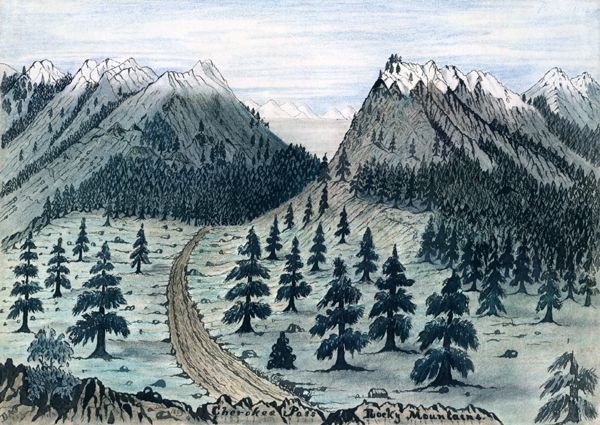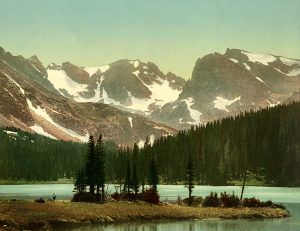
Whispers on the Wind: Unearthing Colorado’s Early Trails and Their Enduring Legends
The American West, a landscape forged in the crucible of ambition, hardship, and breathtaking beauty, pulses with stories. But few regions hold as potent a grip on the imagination as Colorado, a state where the jagged teeth of the Rocky Mountains guard secrets whispered by the wind along ancient paths. These aren’t just lines on a map; they are the arteries of history, etched by the moccasins of indigenous tribes, the worn boots of explorers, the desperate scramble of prospectors, and the iron wheels of pioneers. To walk Colorado’s early trails is to step into a living legend, a tapestry woven from gold dust, sacrifice, and the unyielding spirit of those who dared to chase a dream across the continent.
Long before the cries of "Pike’s Peak or Bust!" echoed through its canyons, Colorado was a land of profound spiritual significance and intricate networks of movement for its first inhabitants. The Ute, Arapaho, Cheyenne, and other nomadic tribes traversed this formidable terrain with an intimate knowledge passed down through generations. Their trails, often following game paths and natural contours, were lifelines connecting hunting grounds, sacred sites, and seasonal camps. These were not merely routes but pathways imbued with ceremony and respect for the land, serving as vital arteries for trade, communication, and cultural exchange.
The Ute, for instance, called themselves "Nuche," meaning "The People," and referred to the Rocky Mountains as "The Shining Mountains," a place of profound spiritual connection. Their trails, often high on mountain passes, were meticulously maintained, reflecting their deep understanding of the environment. One such significant route, later adopted and expanded, was a segment of what became known as the Old Spanish Trail, a grueling 1,200-mile trading route connecting Santa Fe, New Mexico, with Los Angeles, California. This trail, established in 1829, traversed southwestern Colorado, threading through the challenging San Juan Mountains. It was a conduit for Mexican traders laden with woolen goods and Native American slaves, and a path of both opportunity and immense suffering, its dust forever mingled with the sweat and tears of those forced along its unforgiving course.

The arrival of European and American explorers marked a new chapter in Colorado’s trail history, driven by mapping, resource assessment, and territorial claims. Figures like Zebulon Pike, who in 1806 famously failed to summit the peak that now bears his name, and Stephen Harriman Long, whose 1820 expedition mistakenly labeled the region "The Great American Desert," began to sketch the outlines of a land largely unknown to the burgeoning United States. Later, John C. Frémont, "The Pathfinder," meticulously mapped vast swathes of the West in the 1840s, often guided by seasoned mountain men and Native Americans, further opening the door for westward expansion. These early explorations, though often fraught with peril and miscalculation, laid the groundwork for the waves of settlers and fortune-seekers who would soon follow.
The true explosion of trail-blazing in Colorado, however, began with a whisper that quickly became a roar: gold. The discovery of placer gold near Cherry Creek in 1858 ignited the "Pike’s Peak Gold Rush" of 1859, a chaotic, desperate stampede that forever altered the landscape and destiny of the region. Thousands upon thousands of eager prospectors, their wagons emblazoned with the iconic slogan "Pike’s Peak or Bust!" poured into what was then Kansas Territory. They followed crude, often unmarked trails, carved by sheer will and the promise of instant wealth. These new routes, less paths and more migratory channels, were fraught with danger – disease, starvation, hostile encounters, and the ever-present threat of the unforgiving wilderness.
"The journey was harder than any of us imagined," wrote one anonymous prospector in a letter home, "The trails are but tracks in the dust, and the mountains rise like walls against our hopes. Many have turned back, their dreams withered by the sun and the lack of water. But for those of us who push on, there is a fever in the blood, a certainty that gold awaits."
This fever led to the rapid establishment of mining camps that sprang up overnight, evolving into towns like Central City, Georgetown, and later, Leadville and Cripple Creek. Each new strike meant new trails, branching off the main arteries like capillaries, leading into the deepest, most remote valleys of the Rockies. These trails were narrow, treacherous, and often carved directly into cliff faces, a testament to the miners’ desperation and ingenuity. Pack mules laden with supplies, explosives, and equipment navigated these perilous routes, their hooves wearing the rock smooth, creating indelible marks on the landscape.
The early trails were also the domain of the legendary mountain men – independent trappers and traders who lived off the land, often adopting the customs and languages of Native American tribes. Figures like Kit Carson, though more associated with New Mexico, made significant forays into Colorado, their knowledge of the terrain invaluable. These hardy individuals often served as guides for explorers and early settlers, their deep understanding of the mountains, rivers, and wildlife shaping the routes that others would follow. Their solitary lives and frontier skills became the stuff of legend, embodying the rugged individualism of the untamed West.
However, the relentless advance of settlers and prospectors along these new trails came at a devastating cost to the indigenous peoples. The concept of land ownership, foreign to many Native American cultures, clashed violently with the insatiable demand for resources. Treaties were signed and quickly broken, leading to tragic conflicts like the Sand Creek Massacre in 1864, where a peaceful encampment of Cheyenne and Arapaho was attacked by U.S. volunteer cavalry. The trails that once facilitated Native American life now became pathways of encroachment, conflict, and ultimately, forced displacement onto reservations, a painful chapter in Colorado’s history whose echoes still resonate today.
As the 19th century progressed, the era of the individual prospector and the horse-drawn wagon began to wane, giving way to the iron horse. Railroads, engineering marvels of their time, began to snake through the mountains, often following the general corridors of the old trails, or forging entirely new, impossibly difficult paths. The Denver & Rio Grande Western Railroad, known for its narrow-gauge lines, connected remote mining towns like Silverton, Ouray, and Durango, bringing in supplies and carrying out vast quantities of silver and gold. The construction of these railways, with their dizzying trestles and tunnels, was an epic undertaking, demanding immense labor and claiming many lives. The trails now served as feeder routes to the railheads, transforming the flow of goods and people and irrevocably tying Colorado into the national economy.
Yet, even with the advent of modernity, the legends born on those early trails refused to fade. Colorado is a treasure trove of tales of lost mines, phantom prospectors, and spectral stagecoaches. The San Juan Mountains, particularly, are rife with stories of "The Lost Cabin Mine," a fabulously rich vein of gold supposedly discovered by a group of prospectors who perished before revealing its location. Miners, driven mad by loneliness or greed, are said to still wander the high passes, their ghostly figures appearing to warn or tempt new adventurers. Ghost towns like St. Elmo, Animas Forks, and Nevadaville, once bustling hubs of activity, now stand as stark, windswept monuments to boom-and-bust cycles, their empty cabins and decaying saloons whispering stories of fortunes made and lost, of lives lived on the edge.

"Every creak of a floorboard, every gust of wind through a broken window in these old towns, it carries a story," observes local historian Mary Ann Grout. "These are not just abandoned buildings; they are silent witnesses to an incredible chapter of human endeavor and desperation. The spirits of those who walked these trails, they’re still here, woven into the very fabric of the landscape."
Today, many of Colorado’s early trails have been reclaimed by nature, or transformed into hiking, biking, and off-road vehicle routes. Sections of the Old Spanish Trail are recognized as a National Historic Trail, preserving its legacy. Modern adventurers, equipped with GPS and Gore-Tex, still seek the thrill of the wilderness, often unknowingly treading the same paths worn by their predecessors. Historical markers dot the landscape, offering glimpses into the lives of those who came before, reminding us that every turn in a mountain pass, every bend in a river, has a story to tell.
The early trails of Colorado are more than just historical footnotes; they are enduring symbols of the American spirit – a spirit of boundless optimism, unyielding resilience, and sometimes, profound hubris. They represent the human desire to explore, to conquer, and to dream. As the sun sets over the Rockies, casting long, purple shadows across the valleys, one can almost hear the faint echoes of the past: the rhythmic thud of moccasins, the creak of wagon wheels, the clatter of pickaxes, and the hopeful, desperate whispers of those who dared to chase legends across the wild, untamed heart of America. These trails remain, silent witnesses to a bygone era, waiting for new generations to walk their ancient paths and listen to the whispers on the wind.


